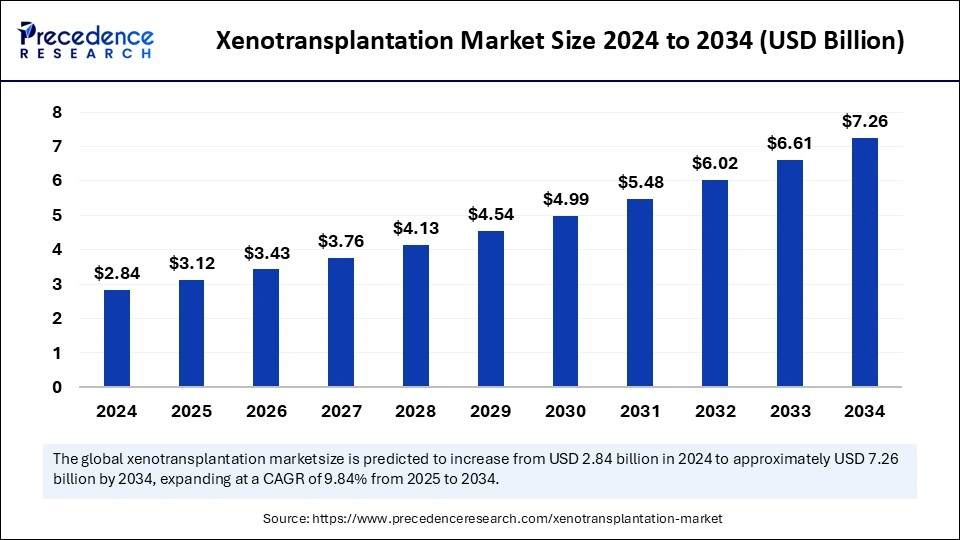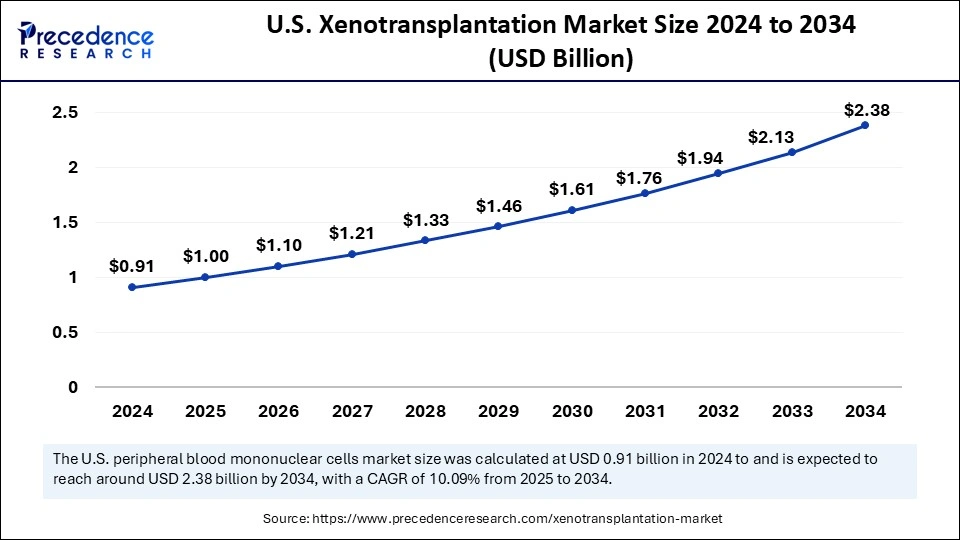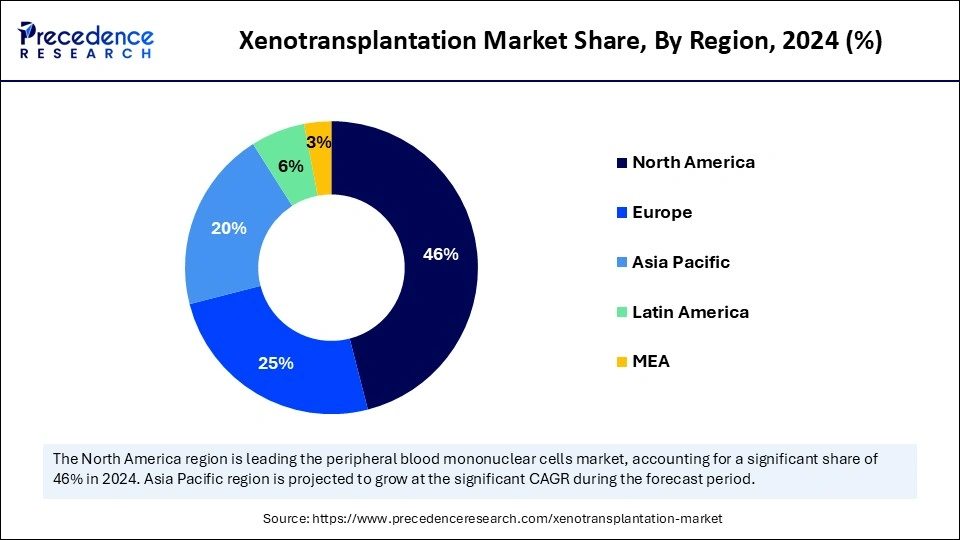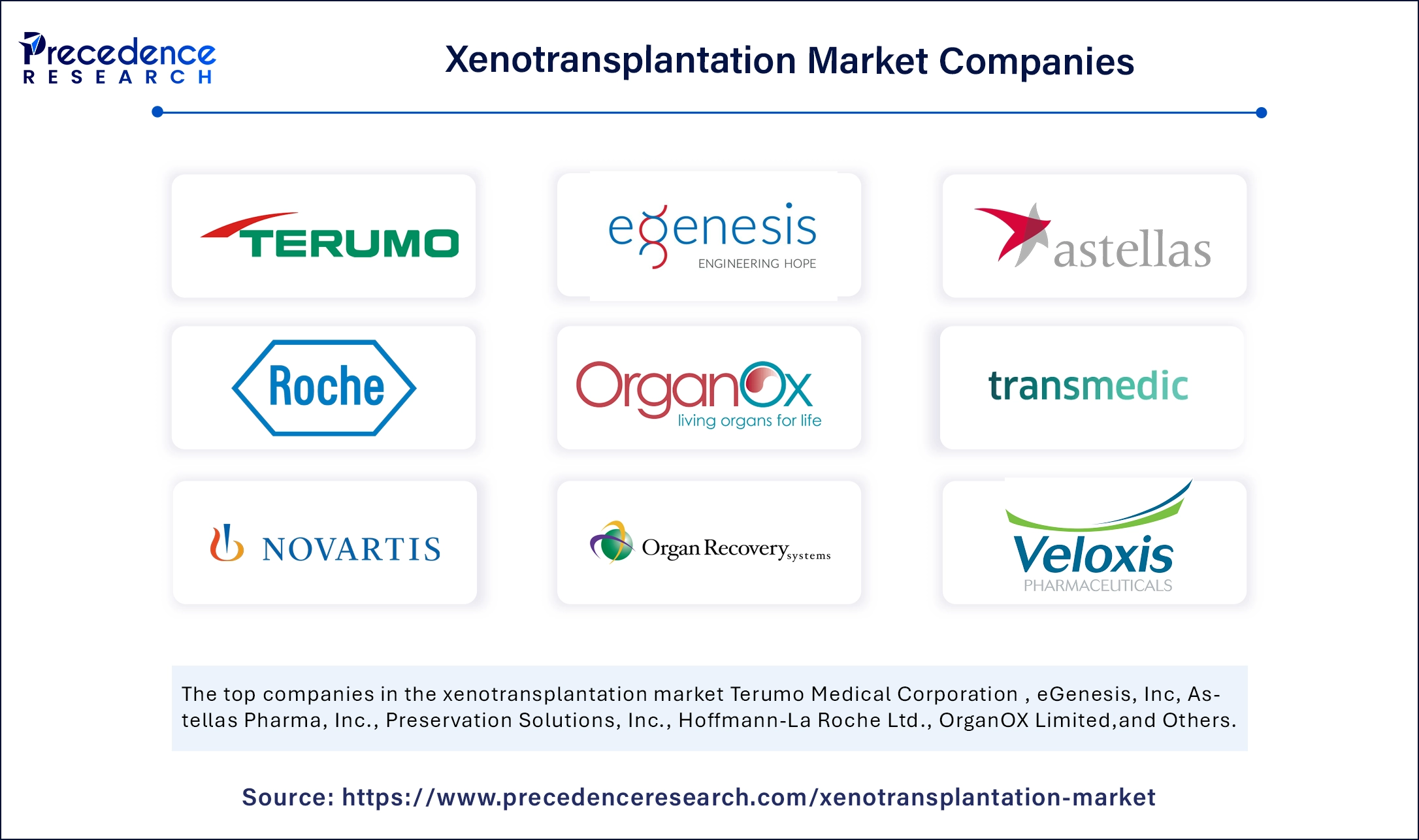The global xenotransplantation market size is calculated at USD 3.12 billion in 2025 and is forecasted to reach around USD 7.26 billion by 2034, accelerating at a CAGR of 9.84% from 2025 to 2034. The North America market size surpassed USD 1.31 billion in 2024 and is expanding at a CAGR of 9.94% during the forecast period. The market sizing and forecasts are revenue-based (USD Million/Billion), with 2024 as the base year.
The global xenotransplantation market size was estimated at USD 2.84 billion in 2024 and is predicted to increase from USD 3.12 billion in 2025 to approximately USD 7.26 billion by 2034, expanding at a CAGR of 9.84% from 2025 to 2034. An increase in cases of kidney and heart diseases around the world is expected to fuel the growth of the market during the forecast period.

Artificial intelligence (AI) is revolutionizing the healthcare sector. AI offers a more precise and accurate approach to medical procedures like xenotransplantation. With AI driven tools, the surgical procedure can be enhanced along with improvements in imaging and diagnostics. AI can analyze various patient data, including diagnostic results and biomarkers, which can help boost the outcomes for patients. AI and machine learning (ML) algorithms can process and analyze vast amounts of data related to a person’s medical history and offer insights that can help medical professionals make informed decisions.
AI technology helps in personalized medicine that suits individual patients and can provide a more tailored treatment for the patient. Predictive analysis is a major benefit of AI because it can help determine the success rate and identify the possible complications through data analysis. AI can be an asset to accelerate research and development activities in this field by helping researchers focus on higher success probabilities, saving resources and time. Such benefits of AI technology will support the growth of the xenotransplantation market in the coming years.
The U.S. xenotransplantation market size was evaluated at USD 0.91 billion in 2024 and is projected to be worth around USD 2.38 billion by 2034, growing at a CAGR of 10.09% from 2025 to 2034.

North America held the largest share of the xenotransplantation market in 2024. This is mainly due to its advanced healthcare infrastructure, providing a foundation for xenotransplantation. Significant investments made in xenotransplantation research and development further bolstered the market in the region. The well-established healthcare infrastructure, along with the integration of advanced technologies, is likely to sustain North America’s dominance in the market in the near future. The increasing prevalence of chronic diseases, like kidney and heart diseases, is supporting this market’s growth. The demand for organ transplantation is steadily increasing in the region, while human organ donors are insufficient.
The U.S. plays a major role in the North American xenotransplantation market. The rising public awareness and acceptance of xenotransplantation is a key factor supporting market growth. The shortage of human organ donors is boosting the adoption of alternative methods like xenotransplants. Moreover, the adoption of advanced technologies in the country is improving the success rate of xenotransplantation, supporting the growth of the market.

Asia Pacific is projected to witness the fastest growth during the forecast period. The ongoing influx of research and development activities in the medical field in this region is a key factor boosting the growth of the market. The rising number of cases requiring organ transplants and the growing prevalence of chronic diseases further drive the market growth in the region. Various Asian countries are investing heavily in improving healthcare infrastructure, which further supports market growth. Countries like Japan and South Korea are poised to play an important part in the market in this region. Increasing government funding for xenotransplantation research is a major factor boosting market growth.
Europe is expected to show notable growth in the xenotransplantation market in the coming years. This is mainly due to the increasing prevalence of chronic diseases and long waiting times for organ transplants. There is a heightened awareness among people about organ transplantation. Moreover, increased funding to strengthen the healthcare infrastructure and adoption of advanced surgical technologies further contribute to regional market growth.
The xenotransplantation method encompasses implantation, transplantation, or even infusion of tissues, liver, cells, or organs from one species to another. These tissues or organs are mostly derived from animals for a human recipient. The xenotransplantation market is growing steadily due to the increasing research and development activities and growing funding for this field. An increase in number of people requiring organ transplants has consistently risen across the world, aiding the growth of this market. Furthermore, a shortage of human organ donors is a key factor boosting this market growth. The rising number of cases of chronic diseases requiring tissue products is impacting market growth. Technological advancements in healthcare services like surgical procedures are helping improve patient outcomes and more people opting for surgeries. The ongoing investment from the private and public sectors alike for the research and development activities of xenotransplantation is driving innovations in the field.
| Report Coverage | Details |
| Market Size by 2034 | USD 7.26 Billion |
| Market Size by 2025 | USD 3.12 Billion |
| Market Size by 2024 | USD 2.84 Billion |
| Market Growth Rate from 2025 to 2034 | CAGR of 9.84% |
| Dominated Region | North America |
| Fastest Growing Market | Asia Pacific |
| Base Year | 2024 |
| Forecast Period | 2025 to 2034 |
| Segments Covered | Type, Application, and Regions |
| Regions Covered | North America, Europe, Asia-Pacific, Latin America and Middle East & Africa |
Increasing Demand for Organ Transplants
The changes in lifestyle patterns are increasing the cases of chronic diseases worldwide. Many chronic diseases, such as diabetes, chronic kidney diseases, and cardiovascular diseases (CVDs), can progress to end-stage organ failure, requiring organ transplantation. Technological advancements have enhanced the accuracy and efficiency of surgical procedures, supporting market growth. Moreover, the lack of availability of organs leads to long waitlists. According to the U.S. Health Resources and Services Administration (HSRA), 17 people die every day awaiting an organ transplant, with approximately 103,223 people on the waiting list in the country. Such a high demand for organ transplants is creating the need for new techniques like xenotransplantation. This method helps reduce the burden on the healthcare system and more patients can get the transplants in minimum waiting time.
Ethical Concerns and High Costs
The major factor limiting the growth of the xenotransplantation market is the ethical concerns regarding this technique. This method raises concerns about animal welfare and the potential for disease transmission. Many believe that the long-term effects of these procedures on humans and animals alike have not been seriously considered or studied. In addition, the high cost associated with xenotransplantation procedures hampers the growth of this market. Since this procedure is complex, it requires high expertise and advanced equipment to improve success rates. This cost factor creates barriers for some patients and encourages them to seek alternative options.
Demand for Xeno Skin and Heart Valves
The rising demand for Xeno skin, which is derived from animal sources, and heart valves for various applications offer lucrative growth opportunities for the xenotransplantation market. Xeno skin finds applications in the treatment of severe wounds or burns that require skin grafts. There is an increasing demand for skin grafts that are effective, but lack of sufficient availability is limiting this process. Meanwhile, the heart valves that are mainly sourced from pigs and cows could be another area of focus. The rise in the number of cases of chronic heart conditions boosts the demand for heart valves. They provide an alternative to human donors.
The organ preservation segment led the xenotransplantation market with the largest share in 2024. The growth of the segment is driven by the shortage of human donors, leading to the increased demand for organ preservation solutions. Technological advancements in organ preservation solutions, such as normothermic perfusion and hypothermic machine perfusion, have enhanced preservation outcomes. These are more viable preservation solutions, which help store organs and tissues for a longer period.
On the other hand, the tissue products segment is anticipated to grow at the fastest rate during the forecast period. The rising demand for regenerative medicine is a key factor driving the growth of the segment. Xenogeneic tissues play a crucial role in regenerative medicine as well as tissue design applications. These tissues are also used in wound healing treatments.
The kidney segment dominated the xenotransplant market in 2024. With the rise in the number of cases of kidney diseases across the world, the necessity of kidney transplants has increased in recent years. The xenotransplantation technique offers a solution to counter the long waiting for human kidney match. Major developments in research of this field have shown promise in assessing the adequacy, safety, and long-term effects for this medical technique, bolstering this segment’s growth.
Meanwhile, the heart segment is projected to grow at a rapid pace in the upcoming period. The segment growth can be attributed to the increasing prevalence of heart diseases. End-stage heart diseases, like CVDs, severe coronary artery disease, and heart valve disease, often require heart transplants. However, xenotransplantation is an ideal solution, enhancing patients' quality of life.

By Type
By Application
By Region
For inquiries regarding discounts, bulk purchases, or customization requests, please contact us at sales@precedenceresearch.com
No cookie-cutter, only authentic analysis – take the 1st step to become a Precedence Research client